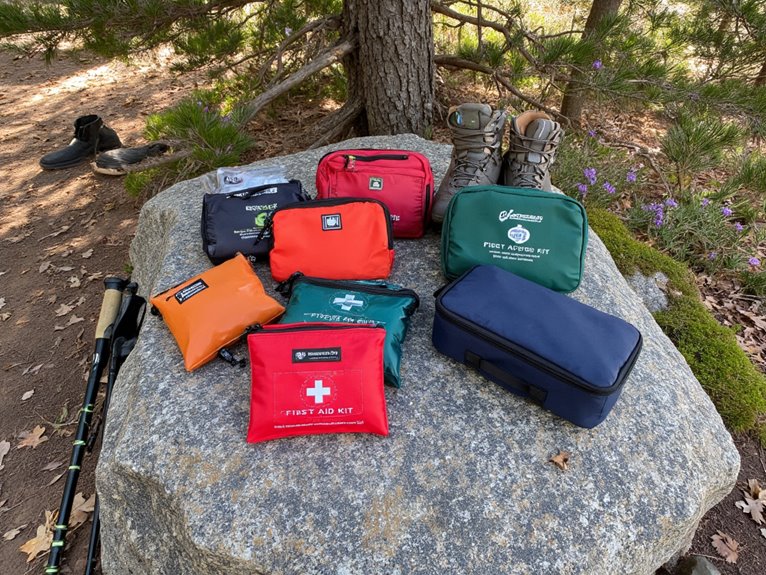What Are the 2 Types of Backpacks in Hiking?
There are two primary types of backpacks in hiking: internal frame backpacks, which feature a stiff internal structure that provides support and stability, and external frame backpacks, which keep the load away from the wearer's back, allowing for improved airflow and reduced sweating. Internal frame backpacks are ideal for multi-day treks, long-distance hiking, and backpacking trips that require carrying heavy or bulky gear. External frame backpacks offer simplicity, durability, and weight distribution, making them a great option for those who prioritize airflow and comfort. As you prepare for your next hike, understanding the unique benefits of each type will help you make an informed decision.
We are supported by our audience. When you purchase through links on our site, we may earn an affiliate commission, at no extra cost for you. Learn more. Last update on 25th December 2025 / Images from Amazon Product Advertising API.
Defining the Internal Frame Backpack
An internal frame backpack, also known as a body-pack or torso-pack, is a type of backpack that features a stiff, internal structure that provides support and stability to the pack, allowing for more efficient load distribution and better weight transfer to the hips and legs.
This design enables hikers to carry heavy loads with greater comfort and endurance.
The internal frame allows the pack to maintain its shape, even when empty, and provides additional protection for the contents.
This type of backpack is ideal for multi-day treks, long-distance hiking, and backpacking trips that require carrying heavy or bulky gear.
Its durability and load-carrying capacity make it a popular choice among serious hikers and backpackers.
Features of Internal Frame Backpacks
In addition to their load-carrying capacity, internal frame backpacks boast a range of features that improve comfort, convenience, and overall hiking experience.
One notable feature is the padded backpanel and shoulder straps, which provide excellent ventilation and comfort during long hikes.
Many internal frame backpacks also come with multiple compartments and pockets, allowing for organized storage and easy access to essential items.
Additionally, they often feature adjustable torso lengths and hipbelts, ensuring a customizable fit for various body types.
Some models may also include features like hydration sleeves, trekking pole holders, and rain covers, making them well-suited for multi-day backpacking trips and rugged outdoor adventures.
Benefits of External Frame Backpacks
External frame backpacks offer a unique set of advantages that make them an attractive option for hikers and backpackers, particularly those who prioritize simplicity, durability, and weight distribution.
One of the primary benefits of external frame backpacks is their ability to keep the load away from the wearer's back, allowing for improved airflow and reduced sweating.
Additionally, external frame backpacks are often more affordable than internal frame backpacks.
Better ventilation: External frames allow for increased airflow, reducing sweat buildup and discomfort.
Easy packing: External frames provide a simple and accessible packing system, making it easier to load and unload gear.
Cost-effective: External frame backpacks are often more affordable than internal frame backpacks, making them a great option for budget-conscious hikers.
Load Capacity and Support System
A backpack's load capacity and support system are critical components that directly impact a hiker's comfort, safety, and overall hiking experience.
Load capacity refers to the maximum weight a backpack can carry, while the support system includes features like hip belts, shoulder straps, and frames that distribute the load evenly.
A well-designed support system helps to reduce fatigue, prevent injuries, and improve overall hiking performance.
When choosing a backpack, hikers should consider their typical load weight and select a pack with a suitable load capacity.
Additionally, look for features like padded hip belts, adjustable torso lengths, and sturdy frames that provide excellent support and stability.
Ventilation and Comfort Features
In terms of ventilation and comfort features, a well-designed backpack can make all the difference in a hiker's overall experience.
Effective ventilation systems and breathable materials work together to regulate body temperature and prevent moisture buildup, ensuring a more comfortable and enjoyable hike.
Mesh Panels Matter
Mesh panels integrated into a backpack's design serve as a crucial feature, allowing for improved ventilation and comfort during extended hikes. By incorporating breathable mesh materials, backpack manufacturers can reduce the buildup of moisture and heat, creating a more comfortable carrying experience. This is especially important for hikers who tend to generate a lot of body heat or hike in warm conditions.
Some key benefits of mesh panels include:
Enhanced airflow: Allowing for a consistent flow of air to circulate around the back and shoulders.
Moisture wicking: Helping to evaporate sweat and reduce clamminess.
Weight reduction: Often, mesh panels can reduce the overall weight of the backpack, making it easier to carry.
Mesh panels integrated into a backpack's design serve as an essential feature, allowing for improved ventilation and comfort during extended hikes.
Breathable Fabric Choices
Backpack manufacturers often opt for breathable fabrics such as nylon, polyester, or cotton blends, which provide superior ventilation and comfort features.
These fabrics allow for airflow and moisture transfer, reducing the buildup of sweat and heat. This results in a more comfortable hiking experience, as hikers can stay cool and dry.
Additionally, breathable fabrics help to prevent blisters and skin irritations caused by excessive sweat and friction.
By choosing backpacks with breathable fabrics, hikers can focus on their journey without distraction from discomfort or discomfort.
Look for backpacks with mesh panels, ventilation channels, and breathable fabric construction to promote superior comfort and performance on the trail.
Moisture-Wicking Lining
Incorporating moisture-wicking linings into backpack design enables efficient sweat evaporation, further enhancing the hiking experience by keeping the back dry and comfortable.
This innovative feature is particularly beneficial for hikers who tend to perspire heavily or undertake long, strenuous treks. By rapidly drawing moisture away from the skin, moisture-wicking linings help prevent blisters and discomfort.
Key benefits of moisture-wicking linings include:
- Enhanced breathability: Allows for rapid evaporation of sweat, keeping the back dry and cool.
- Reduced blisters: Minimizes friction and irritation caused by excessive moisture.
- Improved comfort: Enables hikers to focus on their journey, rather than being distracted by discomfort or pain.
External Frame Backpack Characteristics
External frame backpacks are designed to provide superior load-carrying capabilities, and their characteristics are vital in determining their overall performance.
Three key aspects to examine when evaluating external frame backpacks are the frame material options, load distribution systems, and ventilation features.
Frame Material Options
Three primary materials are used in the construction of external frame backpacks, each with its unique set of characteristics, advantages, and limitations. When choosing an external frame backpack, it's vital to weigh the frame material, as it affects the pack's durability, weight, and overall performance.
Three common frame material options exist:
- Aluminum: Lightweight, corrosion-resistant, and affordable, aluminum frames are a popular choice. They are often used in budget-friendly options.
- Steel: Stronger and more durable than aluminum, steel frames are ideal for heavy loads and rugged terrain. However, they are heavier and more expensive.
- Fiberglass: A lightweight and cost-effective alternative to aluminum, fiberglass frames offer a balance between weight and durability.
When selecting a frame material, prioritize your hiking style, load weight, and terrain to make an informed decision that suits your needs.
Load Distribution System
A load distribution system is a critical component of an external frame backpack, as it enables efficient transfer of the pack's weight to the hips and legs, thereby reducing fatigue and discomfort.
This system typically consists of shoulder straps, a hip belt, and a frame that work together to distribute the load evenly.
The hip belt is particularly important, as it should fit snugly around the hips to transfer the weight effectively.
A well-designed load distribution system allows hikers to carry heavy loads over long distances without excessive strain on their backs and shoulders.
Ventilation Features
Proper ventilation is a crucial aspect of external frame backpacks, as it helps prevent moisture buildup and keeps the wearer cool and dry during extended periods of hiking.
External frame backpacks are designed to promote airflow and reduce sweat buildup, making them ideal for long hikes.
Some key ventilation features to look for include:
Breathable mesh panels allow for maximum airflow and moisture transfer.
Ventilated back panels help to dissipate heat and reduce sweat buildup.
Air-channeling shoulder straps direct airflow around the shoulders, keeping the wearer cool and dry.
Choosing the Right Backpack Type
When selecting a backpack for hiking, it's essential to think about several key factors, including the length and type of trip, your personal comfort preferences, and the specific features that meet your needs.
The right backpack type can greatly impact your hiking experience.
For instance, if you're planning a multi-day trip, you'll need a backpack with ample storage capacity and durable construction.
On the other hand, if you prefer day hikes, a smaller, lightweight backpack may suffice.
Additionally, ponder the features that matter most to you, such as ventilation, compression straps, or pockets for organization.
Considering Your Hiking Style
Your hiking style, whether fast-paced and efficient or leisurely and relaxed, plays a significant role in determining the ideal backpack type for your outdoor adventures. Understanding your hiking style will help you choose a backpack that complements your needs and preferences.
Distance and pace: If you're a fast-paced hiker, you'll want a backpack that allows for easy access to snacks and hydration while on-the-go.
Load and weight: If you're a leisurely hiker, you may prioritize comfort and support over lightweight designs.
Weather and terrain: If you hike in rugged or unpredictable weather conditions, you'll want a backpack that's durable, water-resistant, and adjustable.



